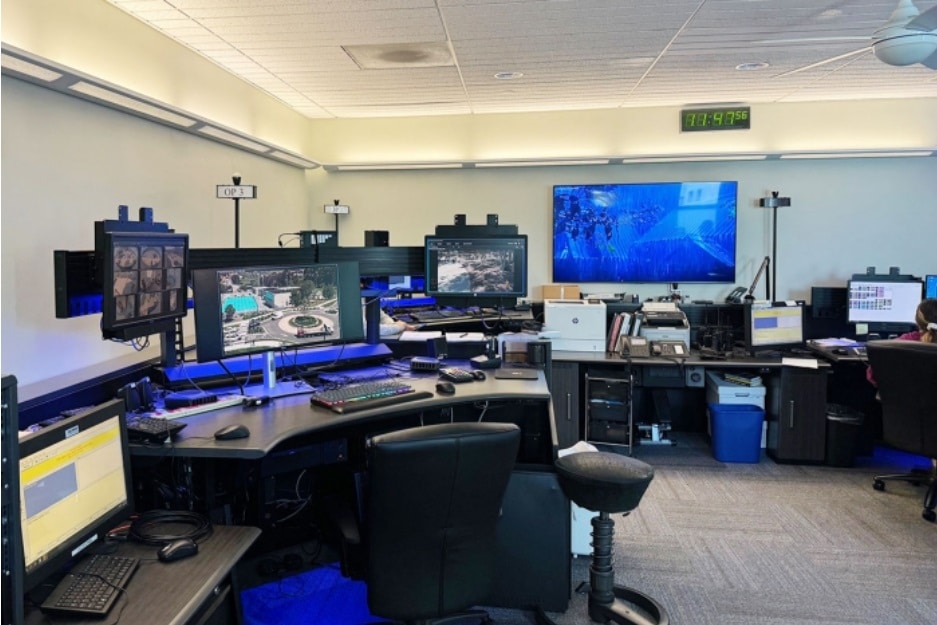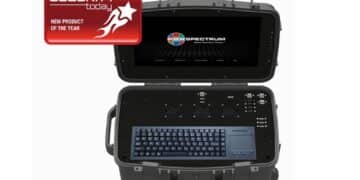RGB Spectrum, a leading designer and manufacturer of mission-critical, real-time audio-visual solutions for a civilian, government, and military client base, offering integrated hardware, software, and control systems, recently partnered with the University of California San Diego (UCSD) Police Department to provide a seamless KVM Solution integrating multiple systems over IP. In this case study, the company details the project.
The client
The University of California San Diego (UCSD) Police Department is a full-fledged law enforcement agency responsible for patrolling, investigating, and preventing crime within its jurisdiction. Spanning over 1,200 acres and comprising 900 buildings, UCSD’s campus presents unique challenges for law enforcement, RGB Spectrum says. The department’s Communications Division serves as the nerve centre, coordinating responses to emergencies, managing communications, and ensuring coordination among officers.
Garrett Williams, a seasoned Sergeant at the University of California San Diego (UCSD) Police Department, oversees the Communications Division. With over two decades of experience, Williams understands the critical role technology can play in public safety.
The challenge
Before partnering with RGB Spectrum, UCSD faced significant obstacles in its dispatch operations. Dispatchers juggled multiple computers, including a CAD, radio, and phone computer, each requiring separate keyboards and mice, RGB Spectrum says.
“Three separate mice and operators constantly moving side to side to look from one to the other and then having to move their hands back and forth between control devices – anytime they have to do that, it’s slowing their workflow down; we figured there had to be a better solution,” Williams said.
“And up to 25% of our operators were suffering from repetitive movement and neck injuries, resulting in downtime and light duty restrictions.”
Why UCSD chose XtendPoint KVM-over-IP
UCSD wanted a seamless KVM solution that integrated multiple systems over IP under a unified interface. It explored various options before discovering RGB Spectrum’s XtendPoint™ solution, which provides local and remote access to source computers, consolidates separate monitors into multi-view displays, and unifies control for more streamlined operation and enhanced efficiency.
UCSD’s key selling point was its ergonomic benefits. It offered a solution to the ergonomic challenges plaguing dispatchers by minimising the need for multiple keyboards and mice. So did replacing monitor clutter. With the XtendPoint solution, single-signal monitors are consolidated on each console using multiview displays that can handle up to four computer signals each or up to eight signals displayed on just two pieces of glass. A notable feature of this solution is the ability to offer each operator customised display viewing, even in a multi-shift operation.
A KVM-over-IP backbone offers additional benefits. Before, only one dispatcher station could see the fire alarm system. With RGB’s XtendPoint KVM system, UCSD expanded access to the fire alarm system at each operator’s station. Now, no matter where dispatchers are seated, they have access to all needed systems.

How UCSD uses RGB’s solution
The RGB Spectrum solution marked a significant turning point for UCSD’s dispatch operations, RGB Spectrum said. Dispatchers experienced a dramatic improvement in efficiency, ergonomics, and situational awareness.
Gone are the days of dispatchers juggling multiple control devices. With a unified interface, dispatchers can control all systems from a single keyboard and mouse. A streamlined workflow accelerated response times and reduced errors.
Video integration proved invaluable. Dispatchers can now access live video feeds and additional mission-critical systems directly within one system interface, providing them with real-time visual information as required.
Additionally, support for video integration with a video wall provided opportunities for enhanced collaboration and situational awareness. Commented Williams, “The flexibility of the RGB system also allowed UCSD dispatchers to leverage video wall capabilities. They can easily share critical information and task lists with colleagues. A more collaborative environment has facilitated communication and coordination among dispatchers, ensuring that tasks are efficiently managed and prioritised during high-stress situations. We can use the RGB system to throw things up on the wall so other dispatchers can see what’s happening and interact as needed.”
“In addition,” said Williams, “the resilience of the RGB XtendPoint system is invaluable in maintaining operational continuity. For example, in the event of a problem at a station, technicians can work on the issue while the dispatcher moves to a backup computer or station, allowing dispatchers to continue critical work without interruption. This proactive approach to system maintainability and resilience saves time and resources and ensures that dispatch operations remain fully functional at all times.”
The Result
The impact of XtendPoint KVM-over-IP on UCSD’s dispatch operations has been profound. UCSD witnessed significant improvements in efficiency, ergonomics, and situational awareness. Efficiency soared as dispatchers seamlessly controlled multiple systems from a single interface. Ergonomic issues were mitigated, and dispatcher morale improved, enabling dispatchers to respond more effectively to emergencies.
Future plans with RGB Spectrum
Looking ahead, UCSD sees opportunities to leverage RGB Spectrum’s technology further to enhance operations.
RGB system’s versatility also enables UCSD to adapt to evolving threats and emergencies. In the event of, say, a building evacuation or siege, for example, UCSD could almost immediately establish a satellite facility.
Williams is enthusiastic about the wraparound monitors RGB has announced. “We are looking at RGB’s new, yet to come to market, 43-inch curved monitors that will be the finishing touch for even better ergonomics and a customised workspace.”
Another potential interest is a “flyaway” kit, a transportable command-and-control system with integral radio access. This mobile system would enable UCSD to monitor special events, such as festivals, where real-time situational awareness is crucial for ensuring the safety of attendees and staff. Williams notes, “We can have a mobile command post set up near a festival or special event, take one of our dispatch systems and put it there without having to move a lot of equipment or figuring out how to get it on the network.”
UCSD also aims to extend the reach of its dispatch operations by providing in-the-field personnel with access to realtime information. By equipping mobile units with RGB’s AV-over-IP systems via smartphones, police officers could receive critical updates and better collaborate with dispatchers to respond to incidents. “If you think of the unthinkable, like a school shooting, it would be ideal to share live coverage of what’s happening, detailed building schematics, and info on weapons the assailant might be using. Who doesn’t want to know what’s potentially happening behind closed doors before walking in? It’s situational awareness on a whole new level,” commented Williams.
The partnership between UCSD Police Department and RGB Spectrum has proven successful. By implementing RGB Spectrum’s solutions, UCSD transformed its dispatch operations to achieve unprecedented levels of efficiency, ergonomics, and situational awareness. And it is just a start.
For more RGB Spectrum news, click here






